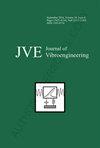The optimization method of CNC lathe performance based on Morris sensitivity analysis and improved GA algorithm
IF 0.9
Q4 ENGINEERING, MECHANICAL
引用次数: 0
Abstract
This study achieved the goal of guiding bed design and optimization by conducting multi-objective optimization research on the performance of CNC lathe beds. In this study, Morris analysis was first performed on the sensitivity of the parameters, and then out to optimize the parameters using a combination of neural network and genetic algorithm. The loss function value, RMSE error accumulation, recall, sensitivity and specificity of the ASSGA-BP optimization model were better. The maximum error between the predicted and true values of the ASSGA-BP model was 0.28 mm. In the performance study of the multi-objective optimization method based on the Morris sensitivity analysis and the improved GA algorithm, the average MAE value is 0.91 %. The average RMSE value is 0.59 %. Also, the new model is significantly better than the NSGA-II, EGA, and FGA algorithms in terms of both the number of final non-dominated solutions and the speed of reaching convergence. The above results demonstrate that the model proposed in this study has high performance, can achieve faster convergence and has the best stability of the convergence state. The innovation of this article lies in the use of the Morris method to screen and evaluate numerous parameters in order to improve the accuracy of the calculation results and ensure the effectiveness of the optimization results. The improved algorithm overcomes the problems of BP neural network and can effectively improve the generalization performance of the neural network, thereby improving the prediction accuracy of the model.基于 Morris 敏感性分析和改进 GA 算法的数控车床性能优化方法
本研究通过对数控车床床身性能进行多目标优化研究,实现了指导床身设计和优化的目标。本研究首先对参数的灵敏度进行了 Morris 分析,然后采用神经网络和遗传算法相结合的方法对参数进行优化。ASSGA-BP 优化模型的损失函数值、RMSE 误差累积、召回率、灵敏度和特异性均较好。ASSGA-BP 模型的预测值与真实值之间的最大误差为 0.28 毫米。在基于 Morris 灵敏度分析和改进 GA 算法的多目标优化方法的性能研究中,平均 MAE 值为 0.91 %。平均 RMSE 值为 0.59 %。此外,新模型在最终非支配解的数量和达到收敛的速度方面都明显优于 NSGA-II、EGA 和 FGA 算法。以上结果表明,本研究提出的模型具有较高的性能,可以实现较快的收敛速度,收敛状态的稳定性也最好。本文的创新之处在于利用 Morris 方法对众多参数进行筛选和评估,以提高计算结果的准确性,确保优化结果的有效性。改进后的算法克服了 BP 神经网络存在的问题,能有效提高神经网络的泛化性能,从而提高模型的预测精度。
本文章由计算机程序翻译,如有差异,请以英文原文为准。
求助全文
约1分钟内获得全文
求助全文
来源期刊

Journal of Vibroengineering
工程技术-工程:机械
CiteScore
1.70
自引率
0.00%
发文量
97
审稿时长
4.5 months
期刊介绍:
Journal of VIBROENGINEERING (JVE) ISSN 1392-8716 is a prestigious peer reviewed International Journal specializing in theoretical and practical aspects of Vibration Engineering. It is indexed in ESCI and other major databases. Published every 1.5 months (8 times yearly), the journal attracts attention from the International Engineering Community.
 求助内容:
求助内容: 应助结果提醒方式:
应助结果提醒方式:


